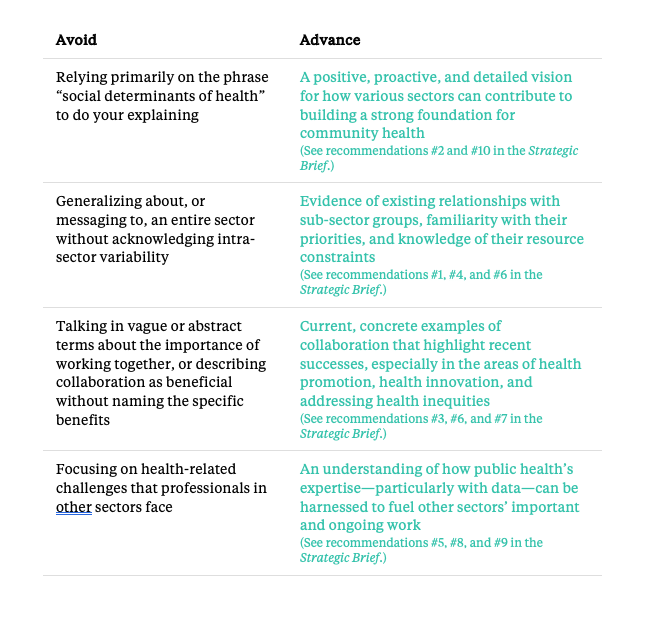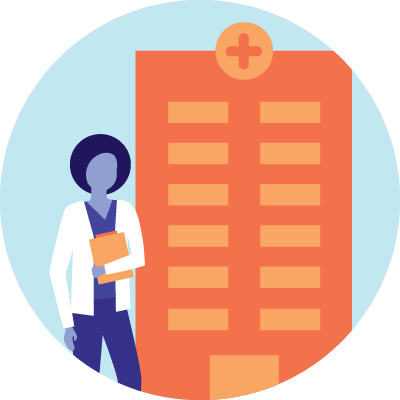
Introduction
In this time of COVID-19, a few basic truths have become plain to see: Our lives are interconnected, our collective physical and mental health is at the heart of a thriving society, and our responsibility to support and maintain the wellbeing of our entire community is shared. These are old refrains for public health advocates, but the world is listening more attentively than ever before. As we step into the fray to talk about the field of public health and how it works, it’s important that we get this right.
Public health’s mission—to ensure the conditions in which everyone can be healthy—depends on being able to forge close partnerships with professionals in other sectors, which in turn, depends on being able to communicate effectively with them. This can be a challenging task, even in the best of times, given that other sector professionals come to the table with their own missions, priorities, and areas of expertise. They often have limited understandings of the public health field, or even health itself as a community issue. As a result, professionals in other sectors are frequently unaware of how public health’s objectives and priorities are aligned with their own. All of this means cross-sector collaboration—which should be a no-brainer—can sometimes be a tough sell.
That’s why FrameWorks, in partnership with the de Beaumont Foundation and the Aspen Institute’s Health, Medicine and Society program, conducted extensive communications research for the PHRASES initiative (Public Health Reaching Across Sectors). Our research identifies the most significant gaps in understanding between public health experts and professionals in other sectors—specifically, housing, education, health systems, and business. We then developed and empirically tested framing strategies that public health professionals can use to most effectively close those gaps.
Why Communicating about Public Health is Tricky
To appreciate why communicating about public health to other sectors is so important, and also how treacherous it can be, we need to understand how professionals in other sectors think. By identifying gaps and overlaps in thinking between different sectors, we can strategically focus our framing efforts.
Gaps At-a-Glance
This “Gaps At-a-Glance” resource offers a summary of key differences between how experts in public health and leaders in other sectors think about the topics of health, public health, and cross-sector collaboration.
For more detailed information, including descriptions of the research process, participants, and findings, you can download the full Map the Gaps report.
Where Some Common Public Health Messages Go Wrong
Given how differently public health experts and professionals in other sectors think about community health, it’s no wonder that some messages get lost in translation.
When You Say[…], They Think[…]
This resource, called “When You Say […], They Think […]”, explains why certain things public health professionals commonly say have the potential to trigger unhelpful thinking.
How a Framing Strategy Makes Effective Communication Easier
When we can anticipate how our communications are likely to be received, we can adjust. Better yet, we can make choices about how to frame our communications that are proven to help get our intended messages across.
QuickStart Guide
You can read about the frames we designed, developed, and tested in our Strategic Brief, which lays out ten framing recommendations. For an overview, check out our “QuickStart Guide” and see the tips below.

Three Frame Elements that Accomplish Essential Tasks
A “frame element” is a communications device that alters the presentation (but not the content) of a message—like a metaphor that helps clarify a concept, a cultural value or shared principle that signals broad relevance, or a particular tone that the messenger adopts. Every communication involves many different frame elements—whether or not they are chosen strategically.
The following frame elements were designed specifically to close critical gaps in understanding between public health experts and professionals in other sectors. They were also tested, in multiple settings, and shown to be extremely effective. Click on an icon below to learn how that frame element works.
Ten Framing Recommendations, Put into Practice
Beyond the three frame elements above, our research identified seven other techniques for moving productive conversations about public health forward—and avoiding the entanglements that can hold them back. These ten recommendations in total, which are listed below, make up a winning framing strategy.
Click on a particular recommendation to see how it looks in practice and learn more.
Recommendation #5: Frame collaboration as empowerment.
Recommendation #8: Foreground public health’s data expertise.
Frequently Asked Questions of Professionals in Public Health—and How to Answer Them
When public health professionals are asked about the work they do, they have a chance to build understanding about the unique perspective and wide range of skills they bring. Unfortunately, several standard responses to these questions have the potential to reinforce misassumptions about the field. The resource below, entitled “Reframed Answers to Tough Questions”, offers guidance on how to respond strategically to FAQs, in order to make the most of these framing opportunities.
Reframed Answers to Tough Questions
You can click on the icon above to download the entire list of questions, including standard as well as reframed answers and associated framing tips. To review them one at a time, see below.
Q: What is public health?
Public health is what we do together as a society to ensure the conditions in which everyone can be healthy. It is about protecting and promoting the health of communities. Public health professionals focus on preventing, detecting, and responding to infectious disease outbreaks, educating about healthy behaviors, and advocating for programs and policies that support these behaviors. We also work to improve health and well-being by addressing the social determinants of health. We know that people who live in clean, safe, and supportive environments with access to the most basic needs have a better chance of leading healthy lives.
Public health is what we build together as a society when we shape our communities so that everyone has what they need for optimal health. The health of our community is like a building—it depends on a strong and stable foundation. Things like quality education, safe and affordable housing, safe drinking water, and access to healthy foods and safe parks lead to positive outcomes for health and well-being for everyone in important ways. A solid foundation will support long-lasting good health for everyone.
Tip:
The Foundation of Community Health metaphor deepens understanding about the social determinants of health—a topic at the center of public health but about which other sectors have limited familiarity or knowledge.
Q: How is public health different from health care?
Public health centers on the health of a community or group of people, whereas health care is centered on individuals. Health care focuses on preventive medicine and treating people with diseases or illnesses, while public health focuses on the underlying social and economic factors that affect the health of everyone in the community. Access to quality and affordable health care services is essential for good health, but it is not sufficient alone. Public health professionals focus on addressing the very conditions in our communities that contribute to making us sick or that can promote health and wellness.
One powerful statistic highlights why health care alone is not sufficient to foster health: The United States spends almost twice as much on health care as other developed nations, yet it has lower life expectancy rates at birth and higher rates of infant mortality.
Public health centers on the health of a community or group of people, whereas health care is centered on individuals. Health care makes up one piece of a strong foundation of health by treating patient-centered illness and disease. Other pieces function by securing the conditions in our communities that promote health and wellness. Ensuring that these conditions are as solid, safe, and stable as possible is the priority of public health professionals. For example, the field works with other sectors to improve the underlying social and economic factors that affect the health of everyone in the community.
Tip:
International comparisons are often counterproductive because Americans tend to rationalize them away. It’s more effective to either avoid statistics or include a more comprehensive and causal explanation of why differences exist.
Q: What does the health department actually do?
Public health wears many different hats, but traditionally the health department has been responsible for protecting the public’s health by using data to track and quickly respond to outbreaks of infectious diseases, strengthening immunization systems, ensuring food and water safety, promoting policies and wellness and education programs to encourage healthy behaviors, and more. Today, we still do all that, but the health department’s role has expanded to focus on preventing the root causes of chronic diseases, such as diabetes, asthma, and heart disease.
Public health departments are changing to meet the needs of the 21st century. Building on the field’s many decades of experience, health departments protect the public’s health by using data to track, quickly respond to, and prevent outbreaks of infectious diseases, ensure food and water safety, strengthen immunization systems and policies, and promote wellness. We are also expanding our role to address the root causes of chronic illnesses, such as diabetes, asthma, and heart disease. Health departments are now looking to use their unique assets, skills, and competencies to form partnerships with other sectors to reduce the incidence and high costs associated with these preventable chronic diseases.
Tip:
Expand people’s limited, and often dated, notions about what the field of public health does by clearly articulating that the field is transforming to meet modern-day challenges and current needs.
Q: Why should public health professionals dictate how people live their lives?
We recognize there is a balancing act between public health’s duty to protect the public’s health and the autonomy that Americans value. But some health decisions individuals make can have broader health consequences that affect others, such as health risks associated with secondhand smoke. We also increasingly have the data to document how the social determinants of health contribute to the high incidence and costs to society of certain diseases, so we often take a leadership role in promoting strategies to reduce these negative health impacts and costs.
Public health professionals promote a range of strategies that support wellness and well-being, and also reduce negative health impacts and costs. Data consistently show that environmental, behavioral, and other factors contribute to the high incidence and costs to society of certain diseases—and that information points to multiple actions we can take together to save money and drive large-scale improvements in health. Also, many health issues have broad community-wide consequences beyond how they affect particular individuals and families, such as exposure to secondhand smoke. Capitalizing on the insights and expert analysis of public health data allows us to manage our shared resources more efficiently when making short- and long-term decisions that affect our country’s overall health.
Tip:
Referencing the perception that public health initiatives pose a threat to individual autonomy risks reinforcing this unproductive association. Instead, make the affirmative case for how public health initiatives improve all people’s lives.
Q: What does housing have to do with public health?
Housing is a significant contributor to a person’s health and wellness. Many housing-related conditions can have a damaging impact on health. Public health recognizes that many of the health challenges experienced in a community are driven by the conditions in which people live, and the quality and safety of their housing is a key determinant of health status.
Safe, affordable housing is part of the foundation for a healthy community. Housing-related problems including overcrowding, utility shutoffs, and the presence of pests, mold, or lead paint can damage our health. Working together, housing and public health professionals can help an entire community reach its optimal health, and also address the living conditions that make people sick rather than continually treating the symptoms of poor health in the local hospital emergency room.
Tip:
Whenever possible, remind people that we can work together to generate positive health outcomes across the community, in addition to reducing health risks and eliminating harms.
Q: How can public health be a help, rather than a burden, when it comes to helping schools meet education mandates?
There is clear evidence that healthy students are more likely to attend school and better able to focus in class. Public health and educators have always known that this leads to better outcomes for students in terms of test scores and high school completion, which in turn is linked to better health outcomes for young adults and beyond. Today, state and federal mandates are holding schools accountable to standards of classroom achievement and absenteeism, and public health can work with schools to better understand and address the community factors that may be driving high rates of absenteeism and poor academic performance.
Nobody knows better than teachers and principals that classrooms are more productive and lessons are more successful when students are healthy. Education professionals are already working overtime to improve test scores and increase attendance and graduation rates in line with state and federal mandates. Public health professionals can support educators by working together to identify, understand, and improve the community factors that limit students’ ability to learn.
Tip:
Demonstrate how public health plays a supportive rather than leading role—one that values and enhances the ongoing work of other sectors without imposing new standards or taking over other professionals’ roles.
Q: What does public health have to do with keeping my employees healthy?
The health of employees (and their families) is significantly affected by the conditions in the communities in which they live. Safe neighborhoods, affordable housing, recreation facilities, a safe water supply, and other factors all contribute to keeping employees and their families healthy, or pose health risks that lead to high rates of sick leave and absences to take care of a sick family member. Public health focuses on the health of the community and works closely with other partners to help create the conditions outside the workplace in which everyone, including employees, can be healthy. Further, building healthier communities helps companies remain economically competitive by supporting the recruitment and retention of a skilled workforce.
Public health professionals create safe environments and healthy conditions for all members of a community—including workers and their families. We recognize that supportive conditions like walkable neighborhoods, affordable housing, recreation facilities, and a safe water supply all keep employees healthy—which cuts down on absences due to sickness or caretaking and reduces rates of personal or medical leave. Further, building healthier communities helps companies remain economically competitive by supporting the recruitment and retention of a skilled workforce.
Tip:
Demonstrate familiarity with the sectors that you wish to engage, particularly when reaching out to the business community. Highlighting specific sub-sector initiatives is an effective strategy.
Q: That idea sounds good… but does public health have any money to pay for it?
Public health, just like other sectors and industries, faces significant funding challenges and is actively advocating for critically needed funding and resources. Additionally, we are exploring ways to partner with other sectors to share resources and to work together to apply for public and private funding to help each other meet shared goals.
Public health, just like other sectors and industries, works to manage resources carefully when making short- and long-term decisions. Reducing the costs associated with poor health and maximizing the protective factors that save money, not to mention time and energy, are top priorities for the field. Even in the face of funding challenges, we continue to explore ways to work together to secure public and private funding that will streamline our collective efforts to meet common goals.
Tip:
Beginning communications with the scope of the problem can trigger crisis thinking, especially in the context of public sector funding. Instead, start with an aspirational vision by appealing to Value of Investment, which emphasizes widely shared commitments to cost reduction and efficiency.
Q: How do we know that public health works?
Public health views evidence as the foundation of informed decision-making. We measure who we are reaching and what works, and we have a long history of success. For example, public health has played a significant role in controlling and preventing infectious diseases, regulating tobacco use, enhancing motor vehicle safety, preventing childhood lead poisoning, and improving preparedness to natural and human-made disasters. When public health is performing as it should, the field is often invisible—it’s hard to count lives saved or injuries averted when children are vaccinated, the water and food supply is safe, and traffic accidents are avoided. But the United States has made significant progress in the last century to improve the health and longevity of its population, and much of that is due to public health achievements.
Public health professionals view data as the key to informed decision-making, much as drivers use GPS to navigate complex terrain. GPS quickly and accurately maps out multiple routes, citing each one’s pros and cons. We constantly assess which populations we’re reaching and measure what works.
We use our data expertise to drive positive health outcomes and move needed solutions forward. For example, public health has played a significant role in controlling and preventing infectious diseases, regulating tobacco use, enhancing motor vehicle safety, preventing childhood lead poisoning, improving natural disaster preparedness, and responding to many other health-related challenges. All of these successes demonstrate the value and effectiveness of the public health field.
Tip:
Use the metaphor of GPS Navigation to explain how public health’s data expertise can help other sectors move toward innovative solutions.
Sample Emails That Model the Framing Strategy
Framing can improve the effectiveness of all forms of communication: written and verbal, formal and informal, long and short. Each of the resources linked below offers “before” and “after” versions of a sample email written by a public health professional and addressed to a potential collaborator in another sector. The reframed (“after”) versions model several of the recommendations described above, and therefore demonstrate how you can use these research-based framing strategies to enhance your everyday communications.
There’s More…
To view additional resources produced as part of the PHRASES initiative, visit www.phrases.org. (Scroll to the bottom of the page if you’d like to subscribe to the PHRASES email list.)
For further guidance on framing during the coronavirus pandemic, please visit our COVID-19 page.
- Introduction
- Why Communicating about Public Health is Tricky
- Where Some Common Public Health Messages Go Wrong
- How a Framing Strategy Makes Effective Communication Easier
- Three Frame Elements that Accomplish Essential Tasks
- Ten Framing Recommendations, Put into Practice
- Frequently Asked Questions of Professionals in Public Health—and How to Answer Them
- Sample Emails That Model the Framing Strategy
- There’s More…






